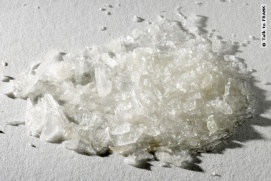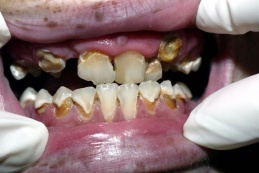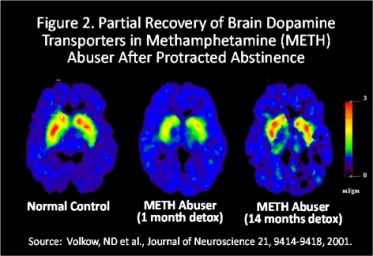Methamphetamine Abuse: Difference between revisions
No edit summary |
No edit summary |
||
| Line 30: | Line 30: | ||
Meth abusers can present with a variety of physical characteristics which can include the following: | Meth abusers can present with a variety of physical characteristics which can include the following: | ||
<br>- Increased heart rate, blood pressure, and respiration | <br>- Increased heart rate, blood pressure, and respiration | ||
- Hyperthermia<br>- Excessive sweating<br>- Dry skin with multiple scabs or open wounds on the face or arms<br>- Scratching or “picking” skin<br>- Track marks on arms or other parts of the body<br>- Rapid speech <br>- Anxiety<br>- Irritability<br>- Insomnia<ref name="Mayo">Mayo Clinic. Drug Addiction. http://www.mayoclinic.com/health/drug-addiction/DS00183/DSECTION=symptoms (accessed 26 March 2012)</ref> | - Hyperthermia<br>- Excessive sweating<br>- Dry skin with multiple scabs or open wounds on the face or arms<br>- Scratching or “picking” skin<br>- Track marks on arms or other parts of the body<br>- Rapid speech <br>- Anxiety<br>- Irritability<br>- Insomnia<ref name="Mayo">Mayo Clinic. Drug Addiction. http://www.mayoclinic.com/health/drug-addiction/DS00183/DSECTION=symptoms (accessed 26 March 2012)</ref> | ||
| Line 36: | Line 36: | ||
<br>More chronic meth users can also present with the following: | <br>More chronic meth users can also present with the following: | ||
<br>- Anorexic appearance (extreme weight loss)<br>- Violent behavior<br>- Confusion<br>- Hallucinations<br>- Paranoia<br>- Delusions of feeling bugs crawling under skin (which leads to excessive scratching and open wounds)<br>- Delusions of grandeur<br>- "Meth Mouth" - severe tooth decay<ref name="Mayo" /><br> | <br>- Anorexic appearance (extreme weight loss)<br>- Violent behavior<br>- Confusion<br>- Hallucinations<br>- Paranoia | ||
- Psychosis | |||
- Seizures<br>- Delusions of feeling bugs crawling under skin (which leads to excessive scratching and open wounds)<br>- Delusions of grandeur<br>- "Meth Mouth" - severe tooth decay<ref name="Mayo" /><br> | |||
[[Image:MethMouth421-1-.jpg|259x173px]]<ref name="mouth">2 Stop Meth. http://www.2stopmeth.org/_global/?q=node/52 (accessed 1 April 2012)</ref> | [[Image:MethMouth421-1-.jpg|259x173px]]<ref name="mouth">2 Stop Meth. http://www.2stopmeth.org/_global/?q=node/52 (accessed 1 April 2012)</ref> | ||
Revision as of 01:33, 3 April 2012
Original Editors - Seth Pinkerton & Jessica Sparks from Bellarmine University's Pathophysiology of Complex Patient Problems project.
Lead Editors - Your name will be added here if you are a lead editor on this page. Read more.
Definition/Description[edit | edit source]
Methamphetamine is a central nervous system stimulant similar to the drug amphetamine and is classified as a Schedule II drug due to its high potential for abuse. It affects the brain by increasing the release and blocking the reuptake of dopamine which is a common mechanism of action for most drugs that are abused.[1]
Dopamine is a neurotransmitter responsible for the reward, motivation, and pleasure centers of the brain. Methamphetamine causes a rapid release of dopamine in the brain resulting in an intense euphoric or grandeur feeling which is the addictive property of the drug.[1]
Methamphetamine is a white, odorless, bitter tasting crystalline powder which can easily be dissolved in water or other liquids. It is taken orally, intranasally (snorting), by smoking, or intravenously.[1]
Meth can be made from common household substances including:
Pseudoephedrine - decongestant
iodine crystals
battery acid
red phosphorus – match boxes and road flares
anhydrous ammonia – fertilizer or countertop cleaner
toluene – brake fluid
hydrochloric acid
acetone – nail polish remover or paint thinner
sodium hydroxide - lye
sulfuric acid – drain or toilet bowl cleaner[3]
Street names include meth, speed, ice, glass, chalk, and many others.[1]
Prevalence[edit | edit source]
add text here
Characteristics/Clinical Presentation[edit | edit source]
Meth abusers can present with a variety of physical characteristics which can include the following:
- Increased heart rate, blood pressure, and respiration
- Hyperthermia
- Excessive sweating
- Dry skin with multiple scabs or open wounds on the face or arms
- Scratching or “picking” skin
- Track marks on arms or other parts of the body
- Rapid speech
- Anxiety
- Irritability
- Insomnia[4]
More chronic meth users can also present with the following:
- Anorexic appearance (extreme weight loss)
- Violent behavior
- Confusion
- Hallucinations
- Paranoia
- Psychosis
- Seizures
- Delusions of feeling bugs crawling under skin (which leads to excessive scratching and open wounds)
- Delusions of grandeur
- "Meth Mouth" - severe tooth decay[4]
Associated Co-morbidities[edit | edit source]
Short Term/Identification/Acute Use Causes:
Euphoria followed by depression
Paranoia
Dilated pupils
Nervousness
Decreased appetite
Rapid eye movement
Dilated pupils
Fever
Excessive swearing
Hallucinations
Aggression
Impaired speech
Increased heart rate[6]
Overdose can cause:
Convulsions
Heart attack
Kidney failure
Stroke (days after OD)[7]
Spike in BP
Abrupt rise in temperature
Rapid respiration
Collapse[6]
Chronic methamphetamine use causes:
Kidney disorders
Lung disorders
Brain damage
Liver damage
Extreme weight loss
Nose bleeds
Constant scratching/picking of the skin
Damaged blood vessels
Insomnia
Malnutrition/ extreme anorexia[6]
Raise in blood pressure, which in severe cases leads to rupture of the aorta
Increase in body temperature
Temporary blindness
Severe permanent vision impairment (temporary loss of blood flow to optic nerve)
Ulcers of the cornea
Temporary emphysema
Concealed heart damage (repairable upon cessation of drug use)[7]
Dependence[6]
In smokable format (considered twice as strong):
Pulmonary edema
Skin affliction
Vasoconstriction (leading to increased BP and/or acidosis)
Ischemic colitis
Duodenal ulcers
Malignant giant gastric ulcers[7]
In inhalant format:
Excessive wear on teeth[7]
With diabetes:
Affects insulin needs[7]
IV/ Sexual Activity:
Blood-to-blood transfers/ sharing drug paraphernalia leads to Hepatitis-C and/or HIV.
70% of MA- dependent women report histories of physical and sexual abuse.[8]
Children of MA abusing parents:
Negligence/abuse
Erratic behavior
Psychiatric instability
High risk for exposure to toxic precursors of MA[8]
Medications[edit | edit source]
There is no one drug that is used to cure methamphetamine addiction but this list offers help to those individuals who are in the process of recovering:
- Bupropion (Wellbutrin) - used to treat depression and cravings
- Topiramate (Topamax) –used to treat cravings and seizures that can occur during withdrawal
- Modafinil – non-amphetamine stimulant shown to improve cognitive functioning[8]
These drugs along with psychological treatment at a drug/rehab facility offer the best hope for the addict to have a successful recovery.[8]
Diagnostic Tests/Lab Tests/Lab Values[edit | edit source]
Urine, hair, breath, saliva, sweat, and blood, along with behavioral and psychological cues are used most often in drug testing.
Due to ease of retrieving a sample, speed of analysis, and low cost, urinalysis is most often utilized. Urinalysis detects the presence of drug metabolites or physical byproducts of the drug’s use.
Most accurate is the use of blood testing, which measures the actual presence of the drug or its metabolite in the blood at the time of the testing. However, these tests are more invasive, expensive, and more time consuming.
Hair testing uses the same technology as urinalysis, but has advantages for detecting use. Using hair testing, drugs can be detected in hair for weeks to months, as opposed to 2-3 days with blood or urine testing.[9]
Etiology/Causes[edit | edit source]
There is not one known cause of methamphetamine abuse but it is thought that the following can lead someone to try meth and subsequently become addicted:
- Genetics (if a parent has an addiction problem it is thought that the child will be more likely to have an addiction problem as well)
- History of physical or psychological abuse
- Risk seeking personality
- Peer pressure
- Low self-esteem
- Anxiety
- Loneliness or Depression
- Ease to make
Systemic Involvement[edit | edit source]
Crystal meth increases dopamine levels in the brain in two ways. First, it increases dopamine release, therefore increasing dopamine in the intercellular space. Because dopamine is a neurotransmitter, this increase produces stronger nerve signals. Second, methampetaminne prevents reuptake of dopamine into the brain cell. Methamphetamine blocks the dopamine transporters, trapping more dopamine within the intercellular space. Because of both of these actions, dopamine accumulates and the cell is bombarded, causing increased stimulation and a stronger signal transmission. Using methamphetamine can cause a 1,500 percent increase in dopamine.
Dopamine is not just utilized in the brain, however. It is used throughout the entire body to initiate the flight-or-flight response.
Cardiovascular:
Dopamine causes an increased heart rate and vasoconstriction in other areas of the body. Because of these responses, the heart requires more oxygen delivered to other organs of the body. However, an increase in blood pressure to accommodate for this need can sometimes prevent blood from returning to the heart due to a decreased motility of blood through the vessels. In some cases, blood vessels that feed the heart constrict, preventing the heart from receiving an adequate blood supply, leading to myocardial infarction. It is possible that instead of experiencing one traumatic event, some methamphetamine abusers suffer multiple small MI’s over time.
Gastrointestinal:
GI motility decreases due to decreased blood flow, which secondarily causes a decreased appetite and less frequent bowel movements. In extreme cases, patients can suffer from bowel ischemia due to insufficient blood flow.
Renal:
When methamphetamine abusers binge, they typically do not drink enough fluids, causing dehydration. Due to dehydration, blood pressure dramatically decreases, causing decreased blood flow to the kidneys. Because of this decrease, binging methamphetamine users are susceptible to kidney failure.
Musculoskeletal:
Methamphetamine use can lead to muscle breakdown, increasing the level of breakdown products such as creatinine phosphokinase (CPK), which is toxic to the kidneys in high concentrations. Continued and increased muscular breakdown can lead to rhabdomylosis, a condition involving extreme muscle breakdown and possible kidney failure. These comorbidities can be prevented by staying hydrated.[10]
Medical Management (current best evidence)[edit | edit source]
The most effective treatments being used today to treat methamphetamine abuse or addiction involves cognitive and behavioral interventions. Trained psychotherapists who specialize in the area of drug addiction are the preferred medical professionals to carry out these interventions.[11]
Initially the meth abuser needs to attend a detox center with trained medical staff to be assessed and treated for physical and psychological complications that can occur as the person’s body is going through withdrawal from the drug.[11]
Cognitive and Behavioral interventions used to treat meth abuse:
- Cognitive Behavioral Therapy (CBT): is based on the idea that thoughts and feelings cause our behaviors, not external factors such as people, situations, and events. This type of therapy aims to help the addict change the way they think and behave to increase coping skills with the stresses of life.[12]
- The Matrix Model: includes intensive individual and group therapy to promote behavioral changes needed to prevent relapse, be abstinent, and establish a lifestyle unrelated to drugs. This can include changing their where they live, the people they associate with, and even their profession.[12]
- Motivational Incentives for Enhancing Drug Abuse Recovery (MIEDAR): an incentive based treatment promoting meth abstinence is another treatment that has shown efficacy in meth abuser through the National Drug Abuse Clinical Trials Network.[11]
Medications such as Wellbutrin are used in conjunction with psychological therapy to treat depression which many recovering addicts suffer from along with the willingness to change can lead to successful recovery.
Physical Therapy Management (current best evidence)[edit | edit source]
add text here
Alternative/Holistic Management (current best evidence)[edit | edit source]
There is no current best evidence to support alternative or holistic management with methamphetamine abuse or addiction.
However many treatment facilities will use the following along with cognitive behavioral therapy and medication to help the abuser or addict cope with their new life without methamphetamine:
- Yoga
- Acupunture
- Meditation
- Equine Therapy
- Art Therapy
Differential Diagnosis[edit | edit source]
- Seizure Disorders
- Parkinson-Plus Syndrome
- Acute Respiratory Distress Syndrome
- Cardiomyopathy
- Hypertensive Heart Disease
- Myocardial Ischemia
- Myocarditis
- Cocaine abuse
- Mushroom abuse
- PCP abuse
- Ketamine abuse
- LSD abuse
- Mescaline abuse[13]
Case Reports/ Case Studies[edit | edit source]
add links to case studies here (case studies should be added on new pages using the case study template)
Resources
[edit | edit source]
Centers for Disease Control and Prevention (CDC): Methamphetamine
Click here to find publicly funded treatment facilities in the USA by state
Recent Related Research (from Pubmed)[edit | edit source]
see tutorial on Adding PubMed Feed
Failed to load RSS feed from http://eutils.ncbi.nlm.nih.gov/entrez/eutils/erss.cgi?rss_guid=1NGmwZeh8JwVIzrKgHG1LrDm0izTr7ViJiDkSYAY2BW5hiXsx0|charset=UTF-8|short|max=10: Error parsing XML for RSS
References[edit | edit source]
see adding references tutorial.
- ↑ 1.0 1.1 1.2 1.3 National Institute on Drug Abuse. http://www.drugabuse.gov/publications/infofacts/methamphetamine. (accessed 25 March 2012)
- ↑ Addiction Treatment Centers. Methamphetamine. http://www.addictiontreatmentcenters.net/about-the-drugs/methamphetamine (accessed 1 April 2012)
- ↑ Meth Project. What's in Meth. http://www.methproject.org/answers/whats-meth-made-of.html?gclid=CI3C--m7j68CFYMKKgodIkCUyQ#Whats-in-Meth (accessed 25 March 2012)
- ↑ 4.0 4.1 Mayo Clinic. Drug Addiction. http://www.mayoclinic.com/health/drug-addiction/DS00183/DSECTION=symptoms (accessed 26 March 2012)
- ↑ 2 Stop Meth. http://www.2stopmeth.org/_global/?q=node/52 (accessed 1 April 2012)
- ↑ 6.0 6.1 6.2 6.3 Fisher G, Roget N. Encyclopedia of Substance Abuse Prevention, Treatment, &amp; Recovery. California: SAGE, 2009.
- ↑ 7.0 7.1 7.2 7.3 7.4 Miller R. The Encyclopedia of Addictive Drugs. Connecticut: Greenwood Press, 2002.
- ↑ 8.0 8.1 8.2 8.3 Galanter M, Kleber H. The American Psychiatric Publishing Textbook of Substance Abuse Treatment. Fourth edition. Virginia: American Psychiatric Publishing, Inc., 2008. p169-176.
- ↑ Potter B, Orfali S. Drug Testing at Work: A Guide for Employers. California: Ronin Publishing, Inc., 1998.
- ↑ Lee S. Overcoming Crystal Meth Addiction. New York: Marlowe & Company, 2006.
- ↑ 11.0 11.1 11.2 11.3 National Institute on Drug Abuse. Topics in Brief: Methamphetamine Addiction: Progress, but Need to Remain Vigilant. http://www.drugabuse.gov/publications/topics-in-brief/methamphetamine-addiction-progress-need-to-remain-vigilant (accessed 1 April 2012)
- ↑ 12.0 12.1 Rawson R, Casey P, Dickow A, Frazier Y, Gallagher C, Galloway G, et al. A multi-site comparison of psychosocial approaches for the treatment of methamphetamine dependence. Addiction 2004; 99: 6. p708-717.
- ↑ Medscape. Methamphetamine Toxicity Differential Diagnoses. http://emedicine.medscape.com/article/820918-differential (accessed 2 April 2012)









